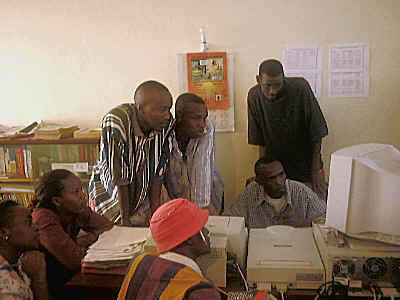



Here at the CLEAN office we did most of the programming for this web
site.
The people from CLEAN let us use their computers outside office hours,
and Austrian writer Martin Auer devoted some time to show us how to use the computer and
to program web pages.
Unfortunately the office is right at the other end of town,
and even scraping together the bus fare is a problem.
As you can read further below, Matumaini Youth Group is affiliated with
CLEAN.
This is were we get our training as para-legal workers and civic educators.
CENTRE FOR LEGAL EDUCATION AND AID NETWORKS
(CLEAN)
ORGANISATIONAL BRIEF
1.0 The Centre for Legal Education and Aid Networks (CLEAN) was established in 1995. It operates as a not-for-profit and non-political organisation registered as a company limited by guarantee. It was registered as such in early 1999.
2.0 The overall goal of CLEAN's programmes is to enhance the capacity ofcitizens, especially the rural and urban poor, to deal with their politico-legalproblems. CLEAN aims to do this by expanding their knowledge base and their capacity to take action whenever need arises.
3.0 The specific mechanism adopted by CLEAN for this purpose is the training of community-based para-legal/civic education workers (PL Ws/CEWs). CLEAN equips them with the capacity to create lega1 awareness, provide legal advice in specific cases, draft legal documents, provide general civic awareness and assist in community mobilisation and dispute resolution. PLWs/CEWs in a particular area operate as a network of CLEAN. They operate on the basis of plans of action which facilitate continuous contact among the community, the PLWs/CEWs and CLEAN. This creates an organisational framework within which social action can be discussed, planned and implemented.
4.0 The creation of awareness and framework for social action all over the regions covered is a long-term programme. CLEAN's participatory and networkinig approach allows flexibility, relevance and dynamism. It also facilitates utilisation of resources in the communities, within other organisations/groups, and in individuals. Both of these enhance CLEAN's capacity to tackle the attendant problems.
5.0 The community-based work carried out by the PLWs/CEWs includes:
· educating community-members in areas of law which are relevant to them, especially legal rights and responsibilities, and mechanisms for pursuit of the same;
· giving advice on matters of law and the legal and administrative procedures to be followed in dealing with any legal problem or resolving legal disputes;
· drafting simple legal or official documents for community-members, and
· in practice, acting as community animators/mobilisers, mediators/arbitrators and advisors/counsellors.
6.0 CLEAN currently has fifteen (15) paralegal networks (PLNs) and two youth networks in
Kenya. The PLNs are Laikipia; Thika; Kitui; Mwingi; Nyakach; Homa Bay; Coast; Embu;
Kirinyaga; Meru; Nairobi; Vihiga, Mbeere and Kangemi (in order of establishment or
affiliation to CLEAN). The youth networks are Youth in Information, Education and
Communication (YIEC) Network (headquartered in Nakuru), and Matumaini Youth Group
(in Huruma Village, Nairobi).
7.0 Besides, CLEAN has contact persons/institutions in Marsabit and Machakos districts; Malindi, Kwale and Kilifi districts; Kakamega district; Kisumu and Siaya districts, and Transmara, Narok, Kajiado, Nakuru, Kericho, Nandi and Trans Nzoia districts, among others in Kenya.
8.0 The main programmes of CLEAN are:
· Participatory Legal Education (PLE), comprising Para-Legal/Civic Education
Training (PLT/CET); Para-Legal/Civic Education Work (PLW/CEW); Participatory
Voter Education Through Training of Community-based Educators and Monitors
(PARVEP) and special training and work through Participatory Theatre in Education
Programme (PATEP);
· Legal Aid and Representation (LAR);
· Materials dbevelopment (MADEV); and
· Internship.
9.0 The programmes which are being developed include:
· Continuous Legal Education (CLE); development of HIV/AIDS legislation;
· Employment Rights Awareness Programme (ERAP); and
· development of School-and-College-based Para-legal and Peace Networks.
10.0 Governance
10.1 The governance structure of CLEAN is based on the principle of selfgovernance, that is, governance by those directly engaged in the actual work and those from collaborating communities within which participatory legal education and aid and general civil education work is being carried out. It was developed during the First, and refined during the subsequent, National Consultative and Programming Workshops, an annual meeting of all the para-legal and connected networks.
10.2 In summary, the structure is as follows:
· Community-based Networkers (COBNETs), composed of all networkers at the community level and providing the policy and programmatic framework;
· Community-based Network Co-ordination Committees (COBNECCOs), composed of the field co-ordinator and at least four other PLWs/CEWs elected from COBNET and co-ordinating grassroots work in each area, and forwarding decisions to the Network Co-ordination board (NECOB);
· NECOB, composed of field co-ordinators from each area/region, elected by COBNECCO, and whose mandate is to provide administrative guidelines for implementation of policy by the Network Co-ordination Committee;
· Network Co-ordination Committee (NECCO) composed of the two Joint Coordinators (JCs); two Assistant Joint Coordinators and two field coordinators from Nairobi and Kangemi PLNs, and overseeing the day-to-day implementation of the programmes;
· The four Joint Coordinators, co-ordinating and taking part in the day-today implementation of the activities; and
· Network Secretariat (NETSEC), composed of all employees and executing the activities of the network.
11.0 The address and contact persons for CLEAN are:
The Joint Coordinators
Maisonette No.3
Ngong' Lane (Off Ngong' Road)
P.O. Box 28472 NAIROBI, Kenya
Telephone: 254 02 573110/573112
Telefax: 254 02 573112
E-mail: clean@nbnet.co.ke
October 12, 1999
NAIROBI